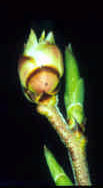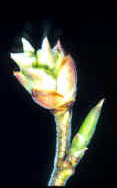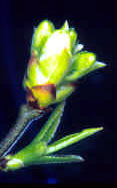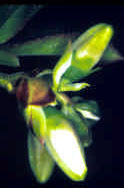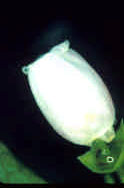216-Flower Primordia Development Stage
Fact Sheet No. 216, UMaine Extension No. 2003
Prepared by David Yarborough, Extension Blueberry Specialist, The University of Maine, Orono, ME 04469. Revised May 2015. Photos taken by Paul Cappiello, former Associate Professor of Horticulture, The University of Maine, Orono, ME 04469.
- 1 Tight bud -4°F.
- 2 Minor scale separation +7°F.
- 4 Inflorescence tip visible +10°F.
Note: Stage figures were revised to be consistent with cultivated blueberry stages.
- 5 All flowers visible but closed +19°F.
- 6 Flowers distended, closed +23°F.
- 7 Fully open flowers +28°F.
Temperature tolerance given is the lowest safe temperature LST in degrees Fahrenheit (°F)
Frost Protection Using Irrigation Systems
The lowest safe temperature (LST) tolerances, listed on the front page, were determined by Dr. Paul Cappiello who was an Associate Professor of Horticulture at the University of Maine. He put blueberry flower buds in a freezer and lowered the temperature at a rate of 7.2°F per hour; when the tissue at the flower bud surface reached the target temperature, they were removed. Tissue was examined on both the surface and inside for injury from the temperature. The LST value was the lowest temperature that a particular tissue stage could withstand without any injury to the plant.
The irrigation system must be designed for frost protection. Frost protection requires that the irrigation system is able to maintain a surface film of water on the plant at all times. A higher density of sprinkler heads and a faster rotation of the heads are required for frost protection, compared to a system used only for irrigation. Big gun irrigation systems are not suitable for frost protection. Consult an irrigation specialist or engineer to design the best system for your field.
Temperature sensors are available which range from inexpensive max/min thermometers to digital units that will sound an alarm once the critical temperature is reached. They should be placed in the lowest part of the field at ground level.
When water is applied through the sprinklers, heat is released when the water turns to ice. As long as a film of water surrounds the ice-coated blueberry plants, the temperature of the ice cannot go below 32°F and the plant will be protected from lower temperatures. The system should be started at 2°F higher than the LST unless there is a breeze; then it should be started at least 4°F higher than the LST. Once started, the system should be operated until all of the ice on the blueberry plants has completely melted, otherwise, injury to the blueberry plant could occur.
About 90% of the time, lowest spring temperatures occur just before dawn on nights with good radiational cooling (clear skies and no wind).
Dewpoint readings in the evening can give an indication of risk of frost the following morning:
- Dewpoints above 50°F: virtually no risk of frost
- Dewpoints 45°F to 50°F: possibility of light frost
- Dewpoints less than 45°F: frost is likely
- Dewpoints in the 30°F range: expect a frost
Information in this publication is provided purely for educational purposes. No responsibility is assumed for any problems associated with the use of products or services mentioned. No endorsement of products or companies is intended, nor is criticism of unnamed products or companies implied.
© 1999, 2002, 2015
Call 800.287.0274 (in Maine), or 207.581.3188, for information on publications and program offerings from University of Maine Cooperative Extension, or visit extension.umaine.edu.
The University of Maine is an EEO/AA employer, and does not discriminate on the grounds of race, color, religion, sex, sexual orientation, transgender status, gender expression, national origin, citizenship status, age, disability, genetic information or veteran’s status in employment, education, and all other programs and activities. The following person has been designated to handle inquiries regarding non-discrimination policies: Director of Equal Opportunity, 101 Boudreau Hall, University of Maine, Orono, ME 04469-5754, 207.581.1226, TTY 711 (Maine Relay System).


